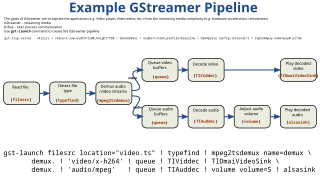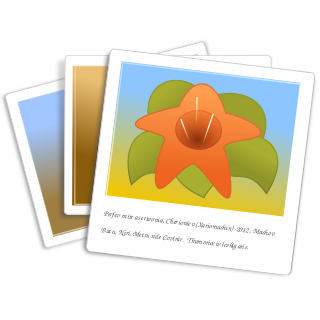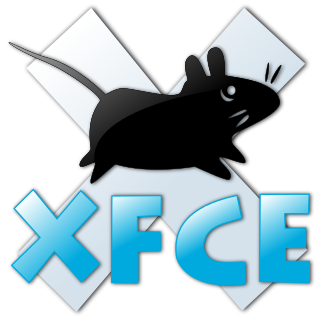
Xfce is a free and open-source desktop environment for Unix and Unix-like operating systems, such as Linux, Solaris, and BSD.

Rhythmbox is a free and open-source audio player that plays and helps organize digital audio files. Rhythmbox is designed to work well under the GNOME desktop using the GStreamer media framework, however it can function on desktop environments other than GNOME.
The following comparison of video players compares general and technical information for notable software media player programs.
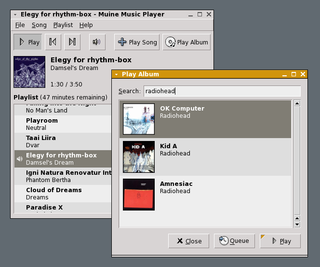
Muine is an audio player for the GNOME desktop environment which runs on Linux, Solaris, BSD and other UNIX-like systems. Muine is written in C# using Mono and Gtk#. The default backend is GStreamer framework but Muine can also use xine libraries.
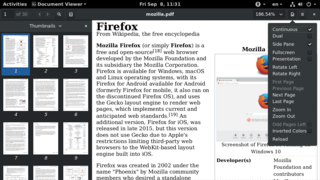
Evince is a document viewer for PDF, PostScript, DjVu, TIFF, XPS and DVI formats. It was designed for the GNOME desktop environment.
The following tables compare general and technical information for a number of notable file managers.
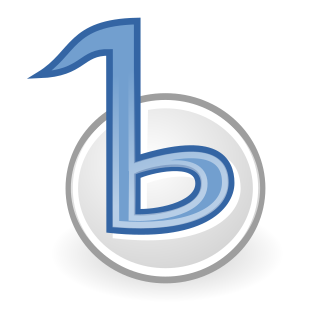
Banshee is a cross-platform open-source media player, called Sonance until 2005. Built upon Mono and Gtk#, it uses the GStreamer multimedia platform for encoding and decoding various media formats, including Ogg Vorbis, MP3 and FLAC. Banshee can play and import audio CDs and supports many portable media players, including Apple's iPod, Android devices and Creative's ZEN players. Other features include Last.fm integration, album artwork fetching, smart playlists and podcast support. Banshee is released under the terms of the MIT License. Stable versions are available for many Linux distributions, as well as a beta preview for OS X and an alpha preview for Windows.

GNOME Commander is a 'two panel' graphical file manager for GNOME. It is built using the GTK+ toolkit and GnomeVFS or GVFS.

Pitivi is an open-source, non-linear video editor for Linux developed by various contributors, with support also available from Collabora. It is licensed under the terms of the GNU Lesser General Public License. Pitivi is designed to be intuitive video editing software that integrates well in the GNOME desktop environment.
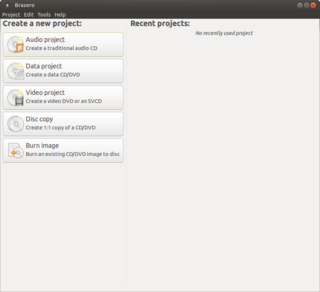
Brasero is a free disc-burning program for Unix-like systems, which serves as a graphical front-end to cdrtools, cdrskin, growisofs, and (optionally) libburn. Licensed under the terms of the GNU General Public License, Brasero is free software.
Clutter is a GObject-based graphics library for creating hardware-accelerated user interfaces. Clutter is an OpenGL-based 'interactive canvas' library and does not contain any graphical control elements. It relies upon OpenGL (1.4+) or OpenGL ES for rendering,. It also supports media playback using GStreamer and 2D graphics rendering using Cairo.
GVfs is GNOME's userspace virtual filesystem designed to work with the I/O abstraction of GIO, a library available in GLib since version 2.15.1. It installs several modules that are automatically used by applications using the APIs of libgio. There is also FUSE support that allows applications not using GIO to access the GVfs filesystems.
OggConvert is a free and open-source transcoder for digital audio and video files of various types into the free Ogg Vorbis audio format, and the Theora, VP8 and Dirac video formats. It supports Ogg, Matroska and WebM containers for output. It is developed by a single author, primarily for Linux. A number of community translations exist for the software.
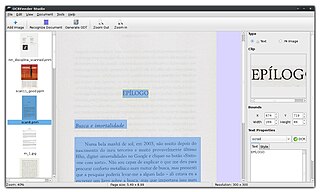
OCRFeeder is an optical character recognition suite for GNOME, which also supports virtually any command-line OCR engine, such as CuneiForm, GOCR, Ocrad and Tesseract. It converts paper documents to digital document files and can serve to make them accessible to visually impaired users.

GNOME Videos, formerly known as Totem, is a media player for the GNOME computer desktop environment. GNOME Videos uses the Clutter and GTK+ toolkits. It is officially included in GNOME starting from version 2.10, but de facto it was already included in most GNOME environments. Totem utilizes the GStreamer framework for playback, though until version 2.27.1, it could alternatively be configured to use the Xine libraries instead of GStreamer.

GNOME Boxes is an application of the GNOME Desktop Environment, used to access remote or virtual systems. Boxes uses the QEMU, KVM, and libvirt virtualisation technologies.




